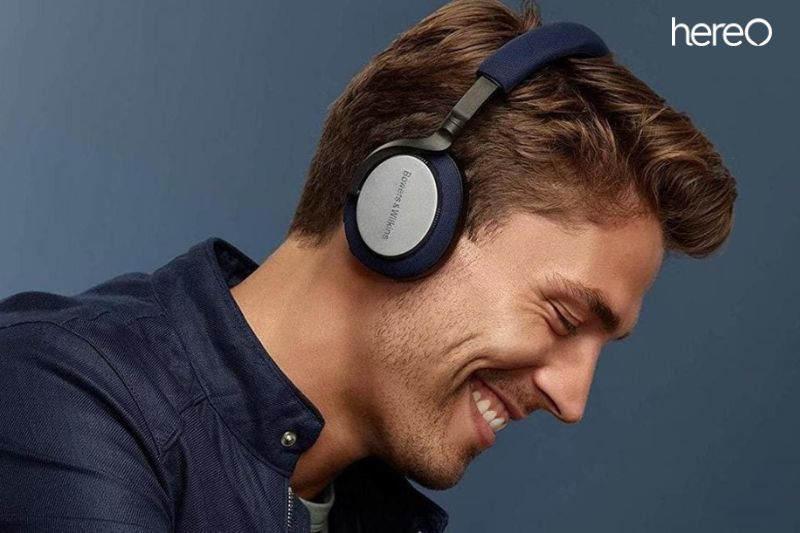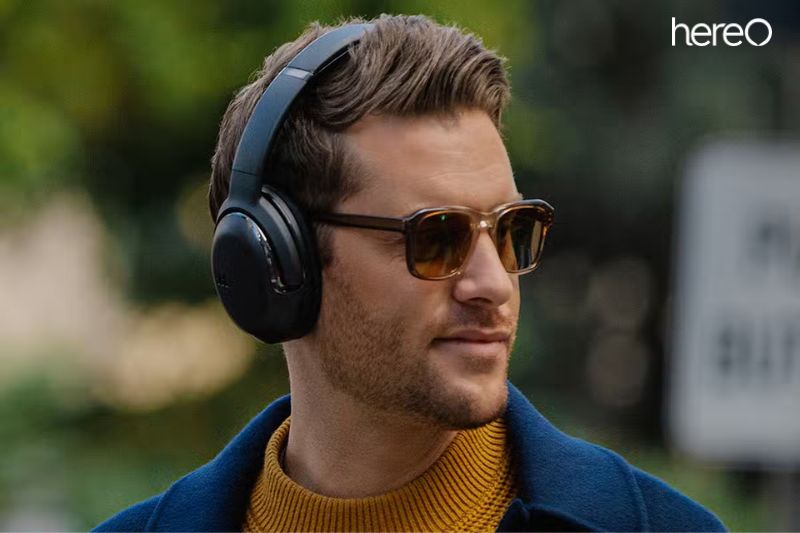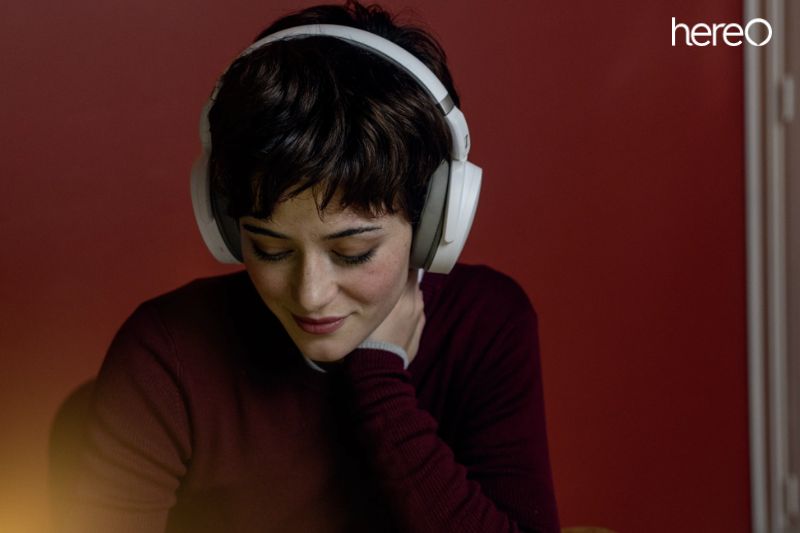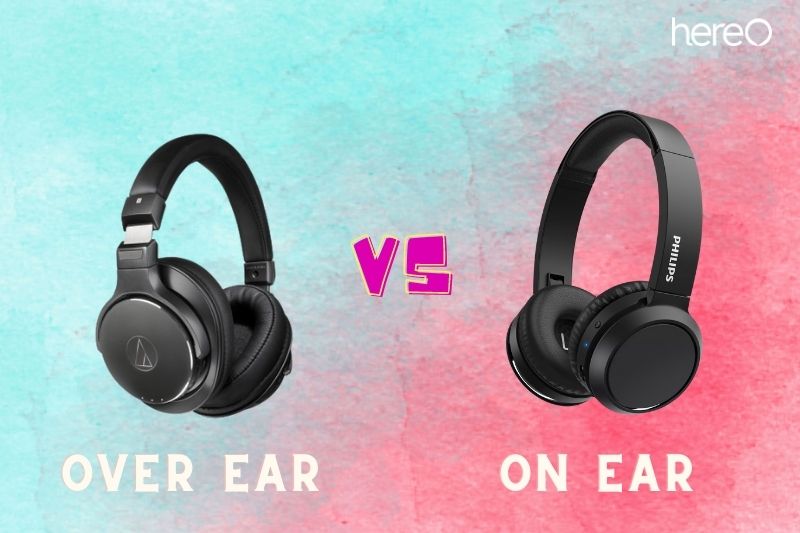All sorts of headphones have seen continual breakthroughs and advancements in recent years. You no longer need to wear bulky, poorly made headsets to get high-quality audio. However, sometimes it’s confusing to decide between over ear and on ear headphones. So, we will compare the difference between over ear vs on ear headphones in this article.
Contents
What is Over Ear Headphone

Over-ear headphones, also known as circumaural headphones, are worn “over” the ears in order to isolate sound. Because they foster a close relationship between you and the music you’re listening to, these headphones are the best type for reducing background noise.
They are excellent at preventing noise leakage, which keeps the sound you are listening to within while letting outside noise out. Open-backed over-ear variants are an option, allowing them to breathe and let sound in and out.
However, because of their preference for their capacity for noise cancellation, isolation, and high-quality sound, this form is typically closed-back.
They don’t pinch your ears like some on-ear models do and are pretty comfy (especially if you upgrade, some cups are even made of velvet and/or leather).
They do have the ability to make you sweat because so little air can get in or out of them. These headphones are also the largest kind available, so if you’re trying to save room, these might not be the best choice.
What is On Ear Headphone

On-ear headphones, as its name suggests, fit over the ears and rest there. On-ear headphones are somewhat smaller (about the size of your actual ear) and fit comfortably on top of them, but over-ear headphones are slightly larger enough that the cups can completely enclose your ears with cushioning.
If people are concerned about the so-called “sound isolation,” the on-ear style, also known as Supra-aural headphones, is much better at blocking out external sounds and is similar to open-back headphones in that it allows some sound from the surrounding environment to exit (as well as get in).
Difference Between On-Ear vs Over-Ear Headphones

Sound Quality
Larger drivers and improved isolation are two benefits of having bigger ear cups. The latter makes sure that the deep bass response is more audible.
Additionally, especially with open-back models, the sound from over-ear headphones sounds more pronounced and lifelike. It seems to make sense that they are the closest substitute for room speakers.
Larger drivers that push more air can be found in larger headphones, which can also be more sophisticated.
When it comes to hearing, the earcup size matters. The best noise isolation, which is necessary to provide a full bass response, is not provided by on-ear headphones.
Of course, there are on-ear headphones that sound fantastic, like the entry-level Grado models.
On-ear models that sound identical to over-ears are eventually impossible to produce due to smaller ear cups and poor isolation.
Comfort
The weight of the frame and the thickness and softness of the earpads also affect comfort.
On-ear headphones are made to be more lightweight by their compact size. Additionally, because the weight isn’t pressing them down, they don’t require as much cushioning on the headband.
However, on-ear fitting can still exert some pressure on your earlobes, which over time begin to ache. Pain may start after several hours or as soon as a few minutes. Choose on-ears with robust padding and a medium amount of clamping force.
More space for your ears in over-ear headphones makes them more comfortable, especially if the earpads are lined with extra-plush memory foam. The clamping force is also more evenly distributed when your ears are entirely covered by earpads.
Although the majority of over-ear headphones are still rather light, more expensive models incorporate sophisticated materials that increase the weight. When choosing large headphones, go for those with a thick headband or those with a suspension headband, like those found in AKG headphones.
Also, keep in mind that not all earpads are created equal in terms of size.
Stability

Full-size headphones that have good stability won’t slip off your head in the middle of a workout if you intend to use them for sports.
It’s also important to address sweating brought on by airflow obstructions. Even if you use earphones, you’ll feel a little hotter because your ear canals serve as literal holes in your skull that help to cool your head.
On-ear headphones are a superior overall choice for sports due to their lightweight nature. Most importantly, you don’t see them as much on your head, which means you are less bothered by them while working out.
Additionally, smaller-surfaced earpads prevent your ears from becoming overheated and fried. Due to the reduced airflow obstruction caused by headphones, you perspire less. Yes, you still perspire while using on-ear headphones, but not as much.
Although there are several excellent over-ear models available, they are too weighty to feel secure while working out. As they bounce on your head more during exercise because they are heavier, headphones are also more noticeable.
Although they cover a wider surface area, earpads prioritize comfort over a firm clamp force. So as you tilt your head back, they can easily slide off your head. Additionally, leather earpads form an airtight seal, which leads to heat buildup. Your skin begins to perspire, which is never enjoyable.
Noise Cancelation
In the end, the support for ANC (Active Noise Cancellation) that the latter design offers is the key feature distinction between on-ear and over-ear headphones. Passive noise cancellation, which is used in both over-ear and on-ear headphones, involves the use of earpads that reduce noise from the environment.
It is comparable to closing a door to block out loud noises from another room in that there is a physical barrier between you and the noise, but nothing actually eliminates it.
Battery Life
Because they are larger, it is natural to anticipate that over-ear headphones will have a longer battery life than on-ear models. Yes, the batteries in over-ear headphones are bigger, but ANC requires a lot of power.
Finally, on-ear headphones often last longer than over-ear headphones—unless you use over-ear headphones with active noise cancellation switched off, in which case they are neck and neck.
On-ear headphones should last 25 to 30 hours of gameplay, while over-ear headphones should last approximately 20 hours. You should be aware that your listening volume will affect battery life.
If you discover that your ears begin to hurt after extended listening sessions, using ANC may enable you to listen to music at a lower volume, which is definitely something to consider.
Portability
The portability of a headphone is influenced by its dimensions, weight, and other features, such as foldable ear cups and a carrying bag.
The size of the on-ear design is its finest feature. They are constructed with less material and are lighter as a result. Additionally, the majority of wireless on-ear headphones fold their ear cups to fit in a larger pocket or a bag.
Comparatively speaking, over-ears are heavier and stiffer than on-ears. They require a lot of space if they aren’t foldable. Even though it increases the bulk, the carrying case at least protects the headphones.
Only models that are more geared toward consumers have a folding mechanism that is somewhat portable. They don’t require as much room when used with a carrying case. They’re still not the most portable alternative because they’re bigger than on-the-ear headphones.
When to Pick On-Ear vs Over-Ear Headphones

When Should You Pick On-Ear Headphones?
For Outdoor use or Portability
Smaller on-ear headphones should be used for commuting if you require something discrete. They are more transportable and lighter. When necessary, they can nevertheless deliver impressive performance while taking up less space.
For Sports Activities
On-ear headphones are the second-best option for athletes who dislike in-ear earbuds since they provide superior stability.
When Should You Pick Over-Ear Headphones?
For Comfort
Your earlobes won’t be compressed by the over-ear design, improving comfort for prolonged listening sessions. Plusher earpads or more luxurious materials are used to adorn more expensive over-ears.
For Quality Audio
To ensure that the music sounds as natural as possible, large ear cups that fit your entire ear canal are required. In addition, the sound is more powerful and spacious-feeling. It sounds more organic and pleasant as a result. The greatest audio reproduction can be found using open-back headphones.
FAQs about Over ear vs On ear Headphones

Is it better to use on ear or over-ear headphones?
There is no incorrect decision, but on-ear headphones are certainly a superior option if battery life and portability are important to you.
An over-ear pair of headphones is what you should get if you want active noise cancellation, slightly better audio quality, and are okay with heavier headphones.
Are over-ear headphones safer than on ear?
The best option, according to experts, is over-ear headphones since they offer superior sound quality and are more effective at blocking out outside noise.
Which is best on-ear or in-ear?
On-ear headphones feature larger drivers than in-ear headphones, which means that in the same quality and price range, they can often reproduce a wider range of frequencies. However, the quality of the sound itself really depends more on the product itself than the style of headset.
Are on ear headphones uncomfortable?
Typically, no. On-ear headphones are just as comfortable as over-ear headphones for the majority of individuals. Typically, over-ear headphones fit over your ears and are sealed to your head. Conversely, on-ear headphones fit over your ears.
Conclusion
Overall, it’s important to understand the advantages and disadvantages of both over ear and on ear headphones. With this knowledge, you can make an informed decision when shopping for a new headset.
If you’re still unsure, then why not try both types and decide which one suits your listening needs best? Click here to browse our selection of over ear and on ear headphones and find the perfect fit for you!
Thank you for reading. HereOfamily hope you enjoy reading this article.
